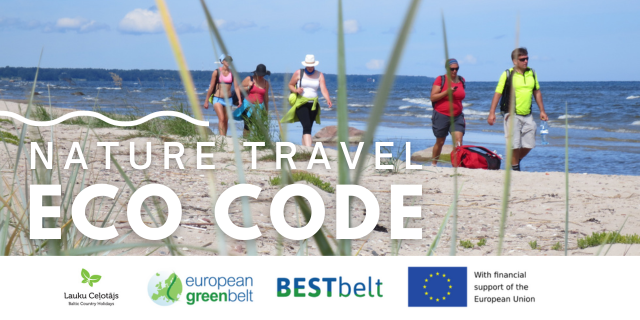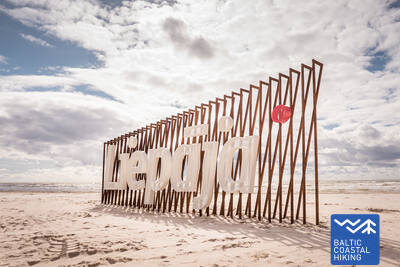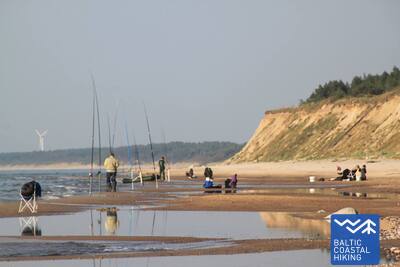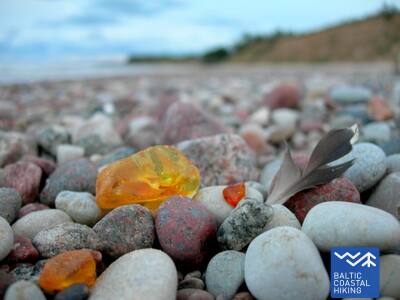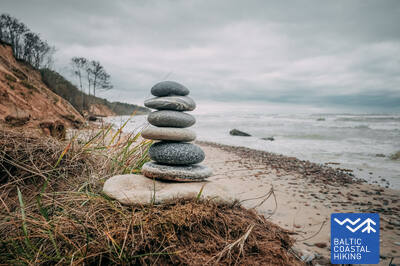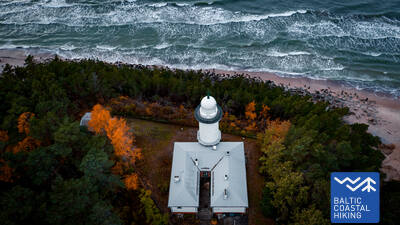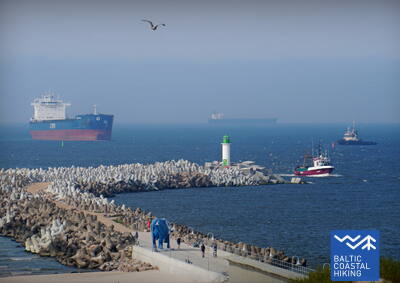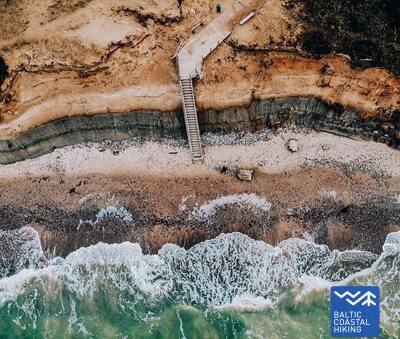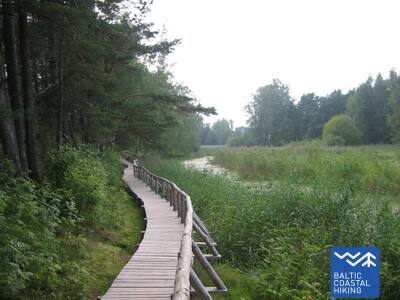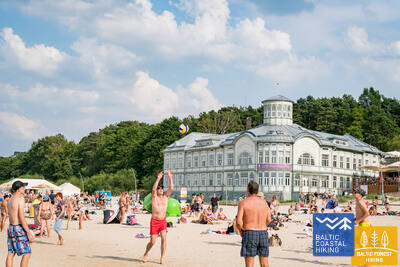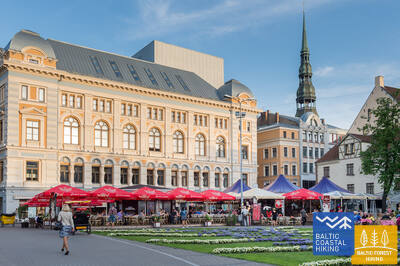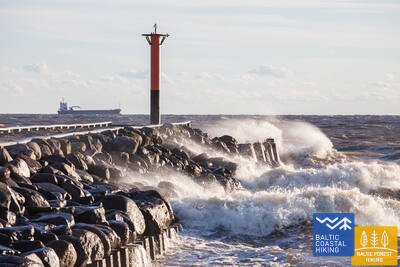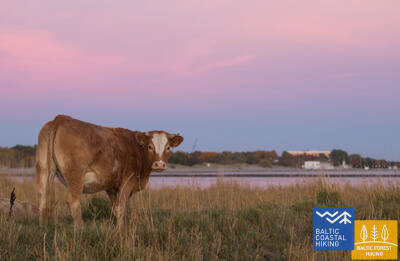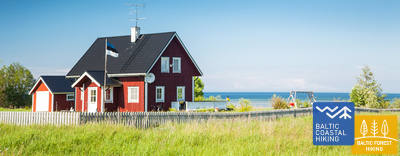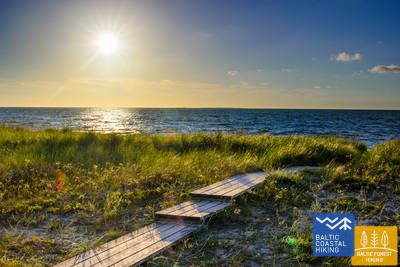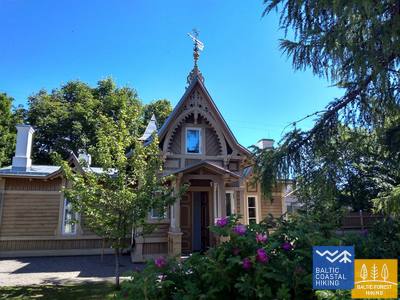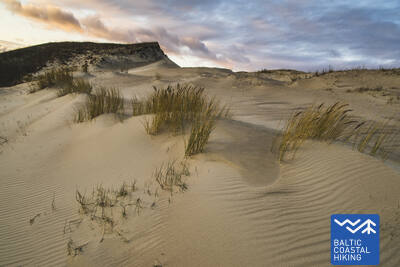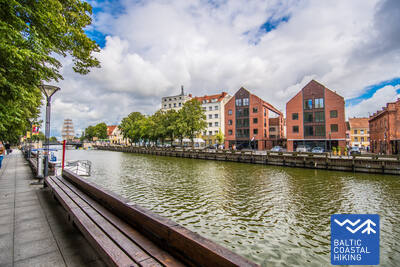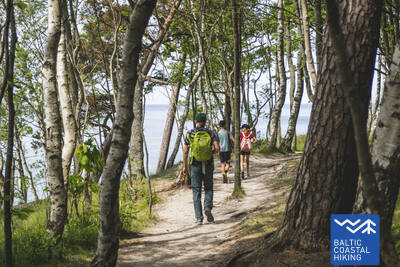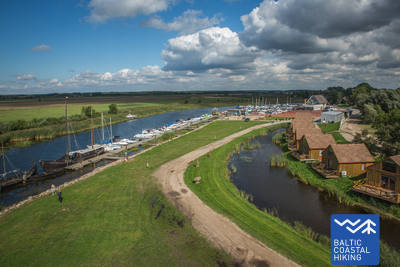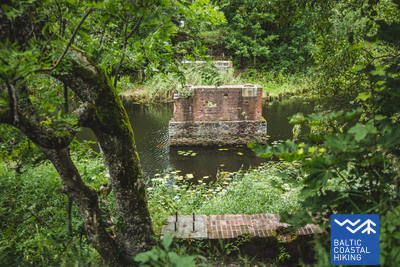Baltic Coastal Hiking trail - Cycling
 Section 3. Bernāti - Liepāja - Karosta (The War Port).
Section 3. Bernāti - Liepāja - Karosta (The War Port).
The City Where The Wind Is Born
From Bernāti to Liepāja, the Baltic Coastal Hiking Route leads through a wide beach where initially the coast is formed by washed away shores, but as you approach Liepāja high foredunes covered in sand ryegrass and marram grass appear in sight. Later the trail winds through the old town of Liepāja and “New Liepāja”, crossing the Naval Port Canal to reach the Naval Port: a complex of military and fortification buildings the visitation of which is likely to take a half day. You should certainly try the special dish of Liepāja called Liepājas menciņi made of smoked cod according to an ancient recipe from Southern Kurzeme.
 Section 4. Karosta (The War Port) - Ziemupe.
Section 4. Karosta (The War Port) - Ziemupe.
Karosta - Military Heritage On The Coast Of The Baltic Sea
The first four kilometers of the Baltic Coastal Hiking Route may interest military history enthusiasts with the remains of many forts and coastal defense batteries, but in terms of walking, this is technically the most complicated section of Kurzeme seacoast. After crossing the Fortress Canal, the Baltic Coastal Hiking Route winds through a coastal meadow for a short while, then darts onto a beach and continues as far as Ziemupe. The beach is wide, in times of stronger winds it gets narrower between the Lenkupe and Kārļupīte Rivers. In some places, there are small bluffs, the rest of the section is composed of high, occasionally washed away foredunes. It is said that a lot of ships have sunk in the depths of the Ziemupe River, one of them even had bronze cannons.
 Section 5. Ziemupe - Pāvilosta.
Section 5. Ziemupe - Pāvilosta.
The Singing Sand and Amber
This beach is rarely visited by people and you can gather pieces of amber and little stones with fossils and hear the singing sand beneath your feet. Near Ziemupe, beautiful bluffs appear, but further on near Akmensrags and Pāvilosta there are beautiful, occasionally washed off foredunes overgrown with sand ryegrass and marram grass. In some places, you can see grey dunes. The Akmeņrags Lighthouse will serve as a good place to rest. Pāvilosta, with its provincial charm and the scent of the harbor and smoked fish will bring you back from wilderness to civilization.
 Section 6. Pāvilosta - Jūrkalne.
Section 6. Pāvilosta - Jūrkalne.
The Most Outstanding Bluffs Around The Baltic Sea
To the northeast of Pāvilosta, there are excellent views of the grey dunes, while only a couple of kilometers further you can see the beginning of one of the most beautiful sections the Baltic Coastal Hiking Route with outstanding bluffs continuing for more than 20 km. The most interesting bluff scenery is located near Strante and Ulmale villages and the estuary of the Rīva River. In many places, orchids bloom on the lower part of coastal landslides in summer. In Jūrkalne and in its surroundings, you can see “two sunsets”: the first one from the beach and the second one from the top of the bluff a couple of moments later.
 Section 7. Jūrkalne - Sārnate.
Section 7. Jūrkalne - Sārnate.
The Place Where People Crossed The Baltic Sea In Boats
The astounding bluffs of the Baltic Sea continue in this section of the Baltic Coastal Hiking Route. Near Ošvalki village, it descends turning into a steeper foredune covered in thick osier wreaths, while opposite to Sārnate village distinct bluffs reappear. Here in this comparatively short walking section you can see several impressive sceneries.
 Section 8. Sārnate - Užava.
Section 8. Sārnate - Užava.
The Most Beautiful Scenery Of The Latvian Seacoast
Near Sārnate, you can still see the bluffs of the Baltic Sea, which slowly become lower towards the North and is replaced by a washed away dam of foredunes. Between Vendzavas village and the Užava Lighthouse, you can see coastal sceneries that are quite unusual for Latvia and that remind one of sandy and rocky deserts with sparse vegetation: it used to be a firing ground for the Soviet army. In this place and in the territories of former firing grounds located beyond the Užava Lighthouse, there are now grey foredunes. Getting closer to the estuary of the Užava River, the beach becomes wider and the dunes – lower. The most beautiful scenery of the Baltic Coastal Hiking Route can be seen from the top of the romantic Užava Lighthouse.
 Section 9. Užava - Ventspils.
Section 9. Užava - Ventspils.
Gather Your Amber Collection!
In this section of the Baltic Coastal Hiking Route, the first 6 km are a lonely stretch of the coast with a wide beach and low foredunes, the tops of which are covered in silvery sand ryegrass and marram grass tillers. After passing the Medole brook, an impressive bluff (~ 19 m high) rises before your eyes with a narrow rocky beach beneath it. The bluff quickly shrinks and then rises again two kilometers further. Between the bluffs, there is a former firing ground for the Soviet army. The last five kilometers of the Baltic Coastal Hiking Route to the South Pier in Ventspils lead through a wide sandy beach, the coastal side of which is delimited by the biotopes of grey dunes.
 Section 10. Ventspils - Staldzene.
Section 10. Ventspils - Staldzene.
Through Ventspils
The itinerary goes through Ventspils and its surrounding forests. The Baltic Coastal Hiking Route winds from the South Pier through the historic Ostgals and the Old Town, crosses the Venta River and continues through the Pārventa District via a pedestrian and cyclist path in the direction of Staldzene where it circles the Ventspils Port and then returns to the seacoast. It is worth taking one “day off” and get to know the most interesting places in the city, as well as visit the Seaside Open-Air Museum.
 Section 11. Staldzene - Oviši.
Section 11. Staldzene - Oviši.
Destination – Cape Oviši
When climbing down to the beach of Staldzene, you can already see a bluff that is a couple of meters high and occasionally barren and that gradually becomes higher and higher (the peak point is Kokkalns, at 29 m). 3-4 km to the SE of Staldzene, a narrow section of beach with a bluff has formed, bathed by the waves during strong winds. After passing Liepene, the washed away coastline is slowly becoming lower and beyond Jaunupe, all the way to Cape Oviši, wide beaches have formed with the widest area situated at the tip of Cape Oviši.
 Section 12. Oviši village - Miķeļtornis village.
Section 12. Oviši village - Miķeļtornis village.
Between Oviši Lighthouse and Miķeļbāka Lighthouse
The Baltic Coastal Hiking Route leads through the Oviši Nature reserve where the typical coastal scenery is formed by wide sandy beaches and dunes. Here, the materials naturally found on the beach, the pebbles and sand, create big natural mosaics. In Lūžņa village, military objects from different periods are of interest to visitors, yet near the estuary of the Lūžupe River the seasonal closure must be observed in order to protect the nesting birds: it is prohibited to go there from 01.04. to 01.08. You must go around this place by following the indications marked in the Baltic Coastal Hiking Route. The destination of the itinerary, the Miķeļbāka Lighthouse, can be seen from afar.
 Section 13. Miķeļtornis village – Sīkrags village.
Section 13. Miķeļtornis village – Sīkrags village.
Destination – Slītere National Park
Starting from Miķeļtornis up to the turn towards the cable bridge over the Irbe River, a wide beach with low, sparse foredunes lays before your eyes. For ~ 4,5 km, the itinerary goes around the estuary of the Irbe River where a seasonal closure is in force in order to protect nesting birds and where it is forbidden to enter from 01.04. to 1.08. By taking a detour, the Baltic Coastal Hiking Route passes through a beautiful pine forest with high dunes the slopes of which are rich with mushrooms and berries. After passing the estuary of the Irbe River and as far as Sīkrags village, you will find a stretch of wide sandy beach and ~ 1 km before reaching Sīkrags you will see the Ķikans brook crossing the beach and marking the border of the Slītere National Park. Also in the territory of Ķikana estuary from 1.04. until 1.08. ~ 600 m long beach and dune section is closed to visitors. During this period, people can cross it along the very shore of the sea without undue delay and keep the dog on a short leash.
 Section 14. Sīkrags - Saunags.
Section 14. Sīkrags - Saunags.
The Livonian Coast
A wide sandy beach stretches from Sīkrags village up to Mazirbe beach which is crossed by the Mazirbe Stream. The Baltic Coastal Hiking Route leads out to the center of Mazirbe village where you can see the Livonian National House. Continuing through small forest and country roads past the former Mazirbe Naval school, it winds through small coastal Livonian villages: Košrags, Pitrags and then Saunags. The Livonian Coastline is the only place where you can learn about the cultural heritage of the other indigenous nation of Latvia. In this section, the indicating signs are in both the Latvian and Livonian language.
 Section 15. Saunags village – Kolka.
Section 15. Saunags village – Kolka.
The Heart Of Europe: Cape Kolka
The Baltic Coastal Hiking Route winds through small country and forest roads from Saunags village to Vaide village where it returns to the seacoast again. Wide sandy beaches stretch up to Cape Kolka turning into low sparse foredunes; wooded seaside dunes continue behind them. For around 2 km, there are washed away dunes followed by the Dumbrkalni Hills. Cape Kolka, the point where the Great Sea meets the Little Sea, is one of the most popular bird-watching sites on the Baltic seacoast.
 Section 16. Kolka - Ģipka.
Section 16. Kolka - Ģipka.
Along The “Closed Coast”
At Cape Kolka, when turning towards the Gulf, you can clearly see the difference between the “Great Sea” and the “Little Sea”. The first 10 km of the Baltic Coastal Hiking Route lead through the coastal area of the Slītere National Park: first, past pine trees that are washed into the sea, past the building of a former fishing kolkhoz, a ship berth and Ēvaži Bluff which is surrounded by an unusually narrow sandy beach with overhanging black alders. The next section of the trail leading to Ģipka also has a narrow sandy beach with pools created by the rich springfens and the mouths of small streams that are shallow in summer. During Soviet times, the seacoast of the Slītere National Park was a closed territory for two reasons: it was a frontier zone and a nature reserve.
 Section 17. Ģipka - Kaltene.
Section 17. Ģipka - Kaltene.
The Rocky Beach of Kurzeme
A sandy beach that is not too wide and has beautiful dunes and coastal pine forests stretches from Ģipka to Roja, but before reaching Roja it is overgrown with reeds. Conversely, the section between Roja and the Kaltene Church is one of the most extraordinary parts of the seashore of Latvia, where the coast is notched by small capes and coves with a very narrow beach. All over the coast, there are piles of boulders of different sizes with the green foliage of black alders hanging over them. In some places, the large gnarled root systems of the trees washed ashore rise before your eyes. In some places, an unpaved road goes right along the coast and a lot of former fishermen homesteads are aligned next to it.
 Section 18. Kaltene - Mērsrags.
Section 18. Kaltene - Mērsrags.
The Multifarious Coast
A truly multifaceted section of the Baltic Coastal Hiking Route in terms of nature, cultural history and scenery. Near Kaltene village, the seashore is speckled with small coves with rocky beaches followed by a thickly overgrown coast where a narrow trail winds its way through reeds and lush vegetation. Further on, the seacoast covered in stones is only a couple of meters wide, in some places it has layers of clay, fields of reeds, in other places, it is carpeted with the algae washed ashore. Sandy beaches with shoals in the sea reappear between Valgalciems village and Mērsrags village. After passing Mērsrags village, the itinerary continues on a road, but when you reach the Lutheran church it turns towards the sea and goes through the coastal meadows as far as the center of Mērsrags village.
 Section 19. Mērsrags - Engure.
Section 19. Mērsrags - Engure.
In the Engure Nature Park
A forest trail surrounded by pine trees leads you from the center of the village to the beach. Next, the Baltic Coastal Hiking Route meanders between a rocky seacoast richly overgrown with reeds and other grasses on one side and wooded seaside dunes on the other side. In some places, the beach is paved with small round stones, in other places you can see grey dunes with a rich variety of plants. Near Bērzciems village, there are large coastal meadows with shoals appearing far away in the sea that are suited for birdwatching. Overgrown seacoast continues up to Abragciems village, while from Abragciems to Engure there is a beach.
 Section 20. Engure - Ragaciems.
Section 20. Engure - Ragaciems.
Fishing Villages And Smoked Fish
At first, the Baltic Coastal Hiking Route winds through Engure village, then leads through a comparatively narrow beach on one side and beautiful woody seaside dunes on the other side reaching Plieņciems Dune after which the sandy beach becomes increasingly wider and large shoals appear in the sea. On the coast, overgrown bluffs equipped with stairs and plank-ways rise before your eyes and stretch as far as the road connecting Kolka and Tukums. You have to take into consideration that on warm summer days a lot of holidaymakers come here. The last third of the itinerary is located in Ķemeri National Park.
 Section 21. Ragaciems - Dubulti.
Section 21. Ragaciems - Dubulti.
The Historic Resort of Jūrmala
In Ragaciems village, you can clearly see the whole length of the Jūrmala coast. The first third of this day's itinerary is part of the Ķemeri National Park where you can get to know historic fishing villages, the Ragaciems village fishing area with net huts and a fish market, dune habitats, as well as watch birds in the estuary of the Starpiņupe River. Starting from Jaunķemeri to Dubulti, the walk takes you across the widest sandy beach of the Gulf of Riga through the historic resort in Jūrmala and the longest city in Latvia. Keep in mind that on warm and sunny summer days there will be a lot of beachgoers.
 Section 22. Dubulti - Lielupe - Bulduri.
Section 22. Dubulti - Lielupe - Bulduri.
The Most Popular Beaches in Latvia
The widest sandy beach of the Gulf of Riga stretches from Dubulti to the Lielupe River. It is the main asset of the Jūrmala resort offering many beach cafés and different recreational possibilities. The coastal dune forests are permeated with a dense web of trails suitable for walking and stick-walking. The part of the Baltic Coastal Hiking Route located between the beach of the Lielupe River and Jūrmala beach is part of the Ragakāpa Nature Park. From here, you can easily get back to Bulduri by taking Bulduri prospekts and the 5th line.
 Section 23. Bulduri - Riga City Center.
Section 23. Bulduri - Riga City Center.
Through the Forests To Riga
The itinerary is an alternative way to get from Jūrmala to Riga by going through the forest. After passing the bridge across the Lielupe River, the Baltic Coastal Hiking Route snakes through Priedaine with its wooden buildings, goes along the right bank of the Lielupe River, then turns towards the Southern part of Bolderāja Dune and crosses Kleisti forest past Lāčupe Cemetery. Next, it goes along the historic roads of Pārdaugava on the West bank of the Daugava River, namely, Buļļu and Daugavgrīvas iela, through Dzegužkalns Hill, passing the Zunda Canal and Āgenskalns bay until reaching the Daugava River, which the route crosses via the Stone bridge and then stops at Town Hall Square.
 Section 24. Riga City Center - Vecāķi.
Section 24. Riga City Center - Vecāķi.
Riga Old Town – a UNESCO World Heritage site
Initially, the itinerary takes you on a small stroll around Riga City Center, Riga Old Town, leads along the City Canal through Kronvalds Park, via Alberta iela (Art Nouveau buildings) and further on via Miera iela through the Lielie kapi Cemetery, via Kokneses and Ostas prospekts through Mežaparks and then it reaches Jaunmīlgrāvis and crosses Mīlgrāvis . Then it meanders along Vecāķu prospekts up to Ziemeļblāzma and the banks of the Old Daugava River (Vecdaugava) separated by only a couple of kilometers from Vecāķi. After a two-day hike through Riga, the Baltic Coastal Hiking Route leads you out to the beach again.
 Section 27. Saulkrasti – Lauči.
Section 27. Saulkrasti – Lauči.
The Gate To The Rocky Seashore Of Vidzeme
The first kilometers leading up to Zvejniekciems can be covered via the beach or via a trail meandering through the dune forest with old pines whose bark looks like crocodile skin. Here you can also see an old wooden hut with fishing nets and tools. Before reaching the port of Skulte, the first rocks appear on the beach of Zvejniekciems. After making a detour around the estuary of the Aģe River and the port, the Baltic Coastal Hiking Route returns to the beach where you can already see Cape Ārņi from afar, while beyond it the brown back of the Big Lauči Sea Boulder comes into view. Varied coastal landscapes.
 Section 28. Lauči - Tūja.
Section 28. Lauči - Tūja.
The Bygone Times Of Sailing Ships
This section of the seacoast of Vidzeme is of outstanding scenic beauty with a lot of rocky capes and boulders in the sea alternating with small, sandy coves where the small streams and rivulets, which dry out in summer, flow into. Occasionally, the beach is completely covered with the gray backs of stones. In some places, small patches of reeds appear, while near Tūja you will see the first sandstone outcrops.
 Section 29. Tūja - Svētciems.
Section 29. Tūja - Svētciems.
The Rocky Beach of Vidzeme
One of the most beautiful sections of the Baltic Coastal Hiking Route, which begins by crossing the Zaķupīte River. Up to the Ķurmrags Lighthouse, there are mostly sandy beaches with small sections of stones. Further on, the Rocky Seashore of Vidzeme starts: capes alternate with small coves, while 4 m high sandstone outcrops emerge on the coast. Sandy beaches continue to prevail after passing Cape Meleki, while before the mouth of the Svētupe River the beach is thickly overgrown and reedy, so it must be bypassed via a forest trail.
 Section 30. Svētciems - Ainaži.
Section 30. Svētciems - Ainaži.
The Lamprey Kingdom
The beach between Svētciems village and Salacgrīva is thickly overgrown, so the Baltic Coastal Hiking Route continues on a forest trail meandering among the dunes. To get from Salacgrīva to Kuiviži, you can take the sandy beach or forest trails. From Kuiviži to the Vēverupe River, you have to bypass the Randu Meadows via a forest road located on the east side of the A1 road. After passing the Vēverupe River, the Baltic Coastal Hiking Route returns to a thickly overgrown beach and then leaves it next to the estuary of the Blusupīte River to reach Ainaži Pier by going along Kāpu and Valdemāra iela. You have covered ~ 580 km in Latvia and reached the state border.
The coastline is not suitable for cycling. However, you can bike certain sections on small roads between Svētciems and Salacgrīva, just beyond Salacgrīva (briefly on a bike path), and between Kuiviži and Ainaži (on a forest road east of VIA Baltica). VIA Baltica is not suitable for cycling (it is dangerous!).
 Section 31. Ikla - Kabli.
Section 31. Ikla - Kabli.
Along the Paths of the Historic Resort
Ikla is the start of the Baltic Coastal Hiking Route in Estonia. In the section connecting Ikla and Treimani, the route leads you along the old Pärnu–Riga road as meadows and reeds stretch across the seashore. After passing Treimani, the trail turns towards the sea and the next 2,8 km are covered across a narrow, sandy or rocky and occasionally thickly overgrown beach. After bypassing the Orajõe Brook, next to the parking lot the trail returns to the beach followed by a hike of ~ 4 km to Hotel Lepanina. There you will have to return to the old Pärnu–Riga road leading you to Kabli. Several good birdwatching sites are located on the itinerary. The coastal area up to Pärnu is a popular relaxation and swimming area.
 Section 32. Kabli - Häädemeeste.
Section 32. Kabli - Häädemeeste.
Birds, Dunes and Forests
This itinerary is particularly recommended for birdwatchers. To cover the section of the Baltic Coastal Hiking Route connecting Kabli and the South of Häädemeeste, you will have to take the old Pärnu–Riga road because reedy meadows and lagoons stretch across the seashore. Before reaching Häädemeeste, the Baltic Coastal Hiking Route branches off from the road and meanders through Jaagupi Nature reserve (going around the east side of the village) running up the backs of high dunes and scooting down to the deep troughs between the dunes covered with a sparse pine forest. Here you will find good places for picking berries and mushrooms.
 Section 33. Häädemeeste - Uulu.
Section 33. Häädemeeste - Uulu.
Through Forests and Bogs
This section of the Baltic Coastal Hiking Route is suitable to hardy hikers who like to travel across uninhabited places. The itinerary leads you through Luitemaa Nature reserve with beautiful conifer forests and inland dunes covered with white carpets of reindeer lichen. In the summer and autumn, you will find suitable places for observing birds and animals, as well as picking mushrooms and berries. The Baltic Coastal Hiking Route winds along the west edge of Maarjapeakse Bog and after running through a mosaic of forests and clearings it leads you to Lepaküla and Uulu villages.
 Section 34. Uulu - Pärnu.
Section 34. Uulu - Pärnu.
Along the Wetlands to Pärnu
First, the Baltic Coastal Hiking Route takes the old coastal roads surrounded by pine forests, but after passing Lottemaa Park it turns towards the sea and comes out at Reiu beach. Next, the hike continues across an overgrown beach (wide shoals when the winds create an outflow of water) and after a little less than 4 km you have to turn inland, cross a golf course and turn in the direction of Pärnu. Near the Raeküla district, it snakes along a small trail forming the border between the large coastal wetland and the forest. Having looped around the wetland for ~ 6 km, the Baltic Coastal Hiking Route emerges at Pärnu beach. Further on, the road goes through the western part of Pärnu Old Town, crosses the Pärnu River and the Sauga River and ends in the Vana-Pärnu district.
 Section 35. Pärnu - Liu.
Section 35. Pärnu - Liu.
The Most Beautiful Views of Pärnu Bay and Smoked Fish
The Baltic Coastal Hiking Route meanders on the outskirts of the west of Pärnu, crosses the Audru River and turns towards Valgeranna, the southern side of which is surrounded by a thick forest and a white sandy beach, while to the north you will find a golf course. After passing Valgeranna, the Baltic Coastal Hiking Route advances between the polders across the northern part of Pärnu Bay. From the Audru polders you will see the most spectacular views of Pärnu Bay. After Audru reeds, the Baltic Coastal Hiking Route turns south and leads through coastal fishing villages with small ports and berths. Here you can see the daily life of fishermen and if you are lucky, then also taste smoked fish.
 Section 36. Liu - Munalaid.
Section 36. Liu - Munalaid.
Bays, islands and birds
The itinerary is suitable for birdwatching. The Baltic Coastal Hiking Route takes roads and trails because coastal meadows, reeds, shallow and overgrown coves cover the seashore. After passing Liu Port, the Baltic Coastal Hiking Route changes its direction several times as the coastline is rugged and difficult to access, so the itinerary must be adapted. The best sightseeing and birdwatching areas are located near Kavaru village, in the surroundings of the Port of Peerni and near Munalaid Harbour where you can see panoramic views of Pärnu Bay and Kihnu Strait with their islands (Sorgu saar, Manilaid, Kihnu) and coastal meadows with cattle grazing there.
 Section 37. Munalaid - Tõstamaa.
Section 37. Munalaid - Tõstamaa.
Pastures, Forests and Coastal Meadows
Wetlands stretch across this section of the seacoast, so the sea is only accessible in a few places. Starting from Munalaid Harbour, the Baltic Coastal Hiking Route winds through Lao village and continues along the roadside up to Tõstamaa. The first exit to the sea is to the south of Seliste, the second one is near the Port of Värati (on the way to Värati there are beautiful coastal meadow landscapes with cattle), while the third one is located in Suti village.
 Section 38. Tõstamaa - Matsi.
Section 38. Tõstamaa - Matsi.
Pastoral Idyll of Estonia
In this section of the Baltic Coastal Hiking Route, you will see a traditional rural landscape. The littoral is notched by shallow coves, peninsulas and capes surrounded by coastal meadows, reeds, shallow lagoons, marshes, as well as hard to access islands. When walking along the small country roads, overhung by red rowans in autumn, you can see ethnographic-like individual farmsteads and farms with cows and goats. The landscapes of farmsteads interchange with the remains of rock fences, farmland and juniper forests. Access to the sea and rest areas are located south of Ranniku and near Kastna village.
 Section 39. Matsi - Varbla.
Section 39. Matsi - Varbla.
Beaches and Forests
Matsi beach is one of the rare sandy beaches in the subsequent section of the trail leading to Haapsalu. The Baltic Coastal Hiking Route takes you on a small stroll through Kulli village and for the next 5 km leads you along small trails surrounded by wide forests and dunes. In autumn, their surroundings are rich in berries and mushrooms. After bypassing Uue-Varbla Manor, the trail reaches Varbla village.
 Section 40. Varbla - Pivarootsi.
Section 40. Varbla - Pivarootsi.
Coastal Manors
The Baltic Coastal Hiking Route goes along coastal roads, yet the sea is only visible in two places as its shore is dappled with shallow coves, small islets, damp coastal meadows, reeds, lagoons, bogs and lakes that have separated from the sea. In the surroundings of Varbla-Allika, you will see farmland scenery, while the Allika-Tamba section mostly goes through beautiful forests. After bypassing the Paatsalu and Illuste Manors, the Baltic Coastal Hiking Route continues on a road crossing wetlands in Nehatu Nature reserve and near Muriste village it meanders along a road, on the side of which there is an impressive rock fence. Before reaching Pivarootsi Manor, vast pastures and a view of the bay appear in sight.
 Section 41. Pivarootsi - Virtsu.
Section 41. Pivarootsi - Virtsu.
The Gate to the Estonian Islands
In this section, an ~ 3,7 km stretch of the Baltic Coastal Hiking Route goes along the former Virtsu-Rapla narrow-gauge railway. The most fascinating place in this section is the Puhtulaiu Peninsula: it is an island that has nowadays merged with the continent. It is covered by a broad-leaved forest with interesting plant and mushroom species, giant trees and memorial sites in honour of important people. Ferries go from the Port of Virtsu to Muhu Island which is connected to Saaremaa Island via a dam.
 Section 42. Virtsu - Kuke.
Section 42. Virtsu - Kuke.
Through Orchid and Juniper Fields
The Baltic Coastal Hiking Route snakes through Virtsu village after which it goes along a motorway for 3 km and then it takes a 90 degree turn towards the northwest, meandering through a wind farm and a former Soviet military airfield, in the surroundings of which orchids bloom beautifully during the summertime. Next, you will see the Suur Väin Strait and beautiful juniper fields. Before reaching the Jõeoja Brook, for ~ 1 km the road goes along the upper part of the ancient seacoast.
 Section 43. Kuke - Meelva.
Section 43. Kuke - Meelva.
Along the Islands of the Baltic Ice Lake
The Baltic Coastal Hiking Route goes along small country roads where individual farmsteads and cultivated fields appear in sight. When approaching Matsalu Bay, you will see wetlands: overgrown lakes that have once separated from the sea as bays and coastal meadows ruined by grazing cattle. Near Mõisaküla (the beginning of Matsalu National Park) and Salevere villages, distinct hillocks appear that used to be islands in the Baltic Ice Lake more than 10 000 years ago.
 Section 44. Meelva - Penijõe.
Section 44. Meelva - Penijõe.
Following the Trail of the Livonian Chronicle of Henry
For this day, the start and end point for the current section of the Baltic Coastal Hiking Route are located in Matsalu National Park, but the major part of it lies outside the park’s territory. Travellers will have their attention captured by the small villages and country roads with beautiful individual farmsteads and rural landscapes with cows and sheep grazing in the grass, as well as Lihula, the first see of the Bishopric of Saare-Lääne (Ösel–Wiek), which is indirectly mentioned in the Livonian Chronicle of Henry in relation to the events of 1211 when Abbot Theoderich of the Daugavgrīva (near Riga) monastery was ordained as the first Bishop of Estonia.
 Section 45. Penijõe - Laiküla.
Section 45. Penijõe - Laiküla.
Around the Largest Wetland in Northern Europe
The Baltic Coastal Hiking Route takes you on a stroll around the Kasari River delta where it flows into Matsalu Bay and where one of the largest wetlands in Northern Europe has taken shape with large reedy fields, coastal meadows, oxbow lakes and water from the shallow bay, being a notable nesting and stopover site for migratory birds. The itinerary mainly leads through farmland landscapes and small villages. In the surroundings of Kirbla, you can see an elevation of the terrain, which is a former Baltic Ice Lake Island with its ancient coast in the north.
 Section 46. Haeska - Puise.
Section 46. Haeska - Puise.
Observing Birds and Nature in Matsalu National Park
One of the most beautiful sections of the Baltic Coastal Hiking Route in Matsalu National Park, which leads through the agricultural lands and coastal meadows located near Matsalu Bay, where thousands of migrating cranes and geese gather in autumn. There are excellent birdwatching sites with towers near Haeska village (coastal meadows, shallow coves, small islets, cattle pastures) and at Cape Puise (coastal meadows with pastures, shoals). The most panoramic views of the sea and strings of islands can be seen in the surroundings of Põgari-Sassi and Puise nina.
 Section 47. Tuuru - Rohuküla.
Section 47. Tuuru - Rohuküla.
The Second Gate to the Islands of the Moonsund Archipelago
In this section of the Baltic Coastal Hiking Route, the landscape is constantly changing. Small villages interchange with cultivated fields, pastures, individual farmsteads and limestone quarries. The route along the seacoast is limited by wetlands and private properties so the itinerary returns to the sea only at Kiviküla and Pusku villages, where you will see the Väinameri Sea Strait and a lot of islands, and at the Rohuküla port.
 Section 48. Rohuküla - Haapsalu - Uuemõisa.
Section 48. Rohuküla - Haapsalu - Uuemõisa.
The Most Popular Resort in Estonia - Haapsalu
A multifarious section of the Baltic Coastal Hiking Route. The first three kilometres of the itinerary go along the former Haapsalu – Rohuküla broad-gauge railway line, takes you on a stroll along Haapsalu Bay through Pullapää cape, crosses coastal forests, which contain health trails, and continues via coastal promenades and small streets around Haapsalu Town. After crossing a small wetland beyond the town, this section of the trail ends in the beautiful Uuemõisa Park.
 Section 49. Uuemõisa - Elbiku.
Section 49. Uuemõisa - Elbiku.
Around Haapsalu Bay
The Baltic Coastal Hiking Route mainly goes along the side of the road and it only winds through smaller country roads between Ingküla and Aulepa Villages, where you can enjoy rural landscapes with individual farmsteads, boulders and pastures.
 Section 50. Österby - Riguldi.
Section 50. Österby - Riguldi.
Noarootsi - The Swedish-like peninsula
The Baltic Coastal Hiking Route leads you to the unusual Noarootsi Peninsula where the Swedish have been linked with shaping the cultural environment. The Noarootsi Peninsula is an excellent site for birdwatching in Estonia. The itinerary leads you through Österby, Pürksi, Hosby and Hara villages, in which you will see different kinds of buildings surrounded by fences. In the north of the peninsula, the trail bypasses the overgrown Vööla meri Lake that has once separated from the sea as a bay. Near the shallow Hara Bay, you can see picturesque landscapes with vast reedy areas, coastal juniper meadows and cattle.
 Section 51. Riguldi - Dirhami.
Section 51. Riguldi - Dirhami.
A Place Marked by Meteorites
With the exception of the first 3 km, the itinerary goes along the seashore. It is mainly a sandy beach with beautiful foredunes, grey dunes and sea boulders. The beach may be covered in algae that has been washed ashore and it is occasionally overgrown with dense vegetation. Opposite Rooslepa village and in other places in the sea and on the coast, there are badly weathered stones or the so-called breccias that have melted and weathered as a result of an ancient meteorite explosion. At the destination of the itinerary, you can spend some time in a pub and from its terrace you will have a beautiful view of the sea and the port.
 Section 52. Dirhami - Nõva.
Section 52. Dirhami - Nõva.
The Harsh Northern Nature
An exceptionally multifaceted section of the Baltic Coastal Hiking Route in terms of landscapes, where you can already get an insight of the nature characteristic to the north coast of Estonia. The itinerary leads you along the seacoast for almost its entire length, where you will find beautiful sandy beaches near coves, beaches covered in boulders at capes, while dolomite layers uncover themselves in the northern part of Cape Põõsaspea (an excellent birdwatching site). The Baltic Coastal Hiking Route goes through Nõva Nature reserve where you will have exceptional views of the white and grey dunes. The beaches are popular for fishing and kite-boarding.
 Section 53. Nõva - Vihterpalu.
Section 53. Nõva - Vihterpalu.
Along the Gulf of Finland
Starting from Rannaküla and after bypassing the wetland, the Baltic Coastal Hiking Route crosses the small Nõva River and leads you to the beach at Keibu Bay (overgrown at the beginning) where a sandy seashore with dunes stretches before your eyes. Near Keibu Brook, it turns inland where its continuation coincides with the trail marked by the Estonian State Forest Management Centre: Peraküla – Aegviidu – Ähijärve. The trail snakes through the small Keibu village and emerges at the beach opposite Alliklepa village with beautiful juniper fields. Further on, the trail leads you between the sea and two small lakes that used to be coves. Opposite them, you will see dolomite outcrops in the seabed. Next, the trail takes a small road along the seacoast (you can see the Pakri Islands) until reaching Vintse village and then it turns towards Vihterpalu.
 Section 54. Vihterpalu - Padise.
Section 54. Vihterpalu - Padise.
A Seven Centuries Old Church and Monastery
The south shore of the Kurkse Strait is covered in wetlands, so the Baltic Coastal Hiking Route turns inland. The greatest part of the Baltic Coastal Hiking Route leads you through large, sparsely inhabited tracts of forest (corresponding with the trail created by the Estonian State Forest Management Centre: Peraküla – Aegviidu – Ähijärve) and sometimes takes you to a more open space or a village.
 Section 55. Padise - Paldiski.
Section 55. Padise - Paldiski.
Paldiski: The Former Closed and Top Secret Town
Starting from Padise up to Karilepa, the Baltic Coastal Hiking Route winds through small country roads, while further on to Madise it goes along the side of the road. From the ancient seacoast of the Madise church hill, you will have magnificent views of Paldiski Bay and the Pakri Islands. From Madise to Paldiski, the itinerary continues along the side of the abovementioned road up to the South Harbour and, by going along it, the route reaches the railway station located in the southern part of Paldiski. During Soviet times, Paldiski was a closed town with a military port and a nearby nuclear submarine training base at the Pakri Peninsula that operated using a small nuclear reactor.
 Section 56. Paldiski - Kersalu.
Section 56. Paldiski - Kersalu.
Cliffs, a Lighthouse and Military Heritage
The Baltic Coastal Hiking Route leads around the Pakri Peninsula, from whose rocky shores you will discover the most beautiful coastal landscapes in northwest Estonia. It goes through the centre of Paldiski and, after having reached the fortress bastions of Peter I, it turns towards the Pakri Lighthouse going across the upper part of the impressive Pakri Cliffs. Further on up to Kersalu, there are both ups in the shape of rocks and downs where the Baltic Coastal Hiking Route meanders along a sandy and rocky seacoast and a beautiful pine forest. Pakri Cliffs are alluring both in cold winters, when impressive icefalls are formed here, and during the time of colourful leaves in autumn.
 Section 57. Kersalu - Laulasmaa.
Section 57. Kersalu - Laulasmaa.
Beaches, Swimming Areas and a Resort
The itinerary leads along the seashore and small coastal villages. Near Kersalu, the Baltic Coastal Hiking Route approaches a rocky shore, where among the trees you will see cliffs rising several meters. When approaching Kloogaranna, wide sandy beaches and dunes appear. Near Kloogaranna beach, the Baltic Coastal Hiking Route turns towards a village, takes you on a stroll of ~ 3 km through the inland and then returns to the seashore.
 Section 58. Laulasmaa - Vääna-Jõesuu.
Section 58. Laulasmaa - Vääna-Jõesuu.
The Most Beautiful Waterfall in Estonia
A multifaceted section of the Baltic Coastal Hiking Route in terms of landscape that is suitable for hardy hikers. There are both rocky and sandy beaches and good swimming areas, fascinating coastal pine forests, the astounding Türisalu Cliff wall and giant sea boulders. By taking the trails of the vast Keila forest park, you can go to the Keila waterfall, near which some fragments of the popular Latvian feature film Vella kalpi (Devil’s servants) were shot, and you can also get to know the exhibition dedicated to the life of coastal fishermen in Lohusalu village.
 Section 59. Vääna - Jõesuu - Tabasalu.
Section 59. Vääna - Jõesuu - Tabasalu.
The Fabled Suurupi Peninsula
One of the most complicated sections of the Baltic Coastal Hiking Route, suitable only for experienced hikers. The itinerary circles the Suurupi Peninsula where the dense forests conceal the military heritage of different eras. The Baltic Coastal Hiking Route meanders through overgrown and rocky seacoasts, birch groves, along former pioneer camps and sand-stone cliffs protecting coves with sharp capes. In some places, the sea uncovers its dolomite base, while in other places you can see boulder “islands”. At the end of the itinerary, one of the most astounding outcrops of the Estonian littoral rises before your eyes – the Rannamõisa Cliffs, which gives views of Kakumäe Bay and Peninsula and the towers of Tallinn’s Old Town.
 Section 60. Tabasalu - Tallinna sadam.
Section 60. Tabasalu - Tallinna sadam.
Tallinn – A UNESCO World Heritage Site
Near Tabasalu, the Baltic Coastal Hiking Route crosses the boundary of Tallinn and goes through the Tiskre and Vismeistri districts to reach Kakumäe beach, where it takes you on a stroll around the wooded upper part of the Kakumäe Peninsula surrounded by cliffs. Here, you will have a vista of the Port of Tallinn across Kopli Bay. Opposite the Õismäe district, an excellent promenade goes along the seashore. After bypassing the Estonian Open-Air Museum, the Baltic Coastal Hiking Route winds along the coastal promenade up to Stroomi beach and after passing the Pelguranna district it takes pedestrian sidewalks to the Estonian Maritime Museum, where it leads you, via the coastal promenade, to the Port of Tallinn, marking the end of the Baltic Coastal Hiking Route. You have covered ~ 620 km in Estonia.
 Section 64. Nida – Pervalka.
Section 64. Nida – Pervalka.
Along the coast of the Curonian Lagoon
The Baltic Coastal Hiking Route starts in the center of Nida, by the port. In Nida, the trail winds along the Curonian Lagoon walkway which offers beautiful views of the expansive waters all the way to Rusnė Island on the east coast of the Curonian Lagoon. Nida features the typical architecture of the Curonian Spit region — one-storey wooden buildings with tile or reed roofs and window shutters painted blue and white. From Nida to Bulvikis Cape (shortly before the cape there is an abandoned runway), the Baltic Coastal Hiking Route winds through single-track forest trails up and down the pine-covered dunes, occasionally coming out onto beachside meadows with scarce vegetation. Rest spots and bird watching towers are available along the trail. The next section features unique open seaside meadows covered in lichens and vegetation characteristic to the Curonian Spit. The Baltic Coastal Hiking Route follows the coastal walkway in the village of Preila. It then winds through forest trails, briefly also following a pedestrian/cyclist lane and coastal paths, eventually reaching Pervalka. This section leads through the Curonian Spit National Park.
 Section 65. Pervalka – Juodkrantė.
Section 65. Pervalka – Juodkrantė.
Along the most majestic sand dunes in Northern Europe
Having departed Pervalka, the Baltic Coastal Hiking Route follows a pedestrian path to cross the Curonian Spit in an east–western direction, arriving at the coast of the Baltic Sea. The next section of 13 km leads along a beautiful, sandy beach protected by high and steep sand dunes on the east. It is called the protective dune ridge and it has been man-made in order to protect the inland from the movement of sand. Entering Juodkrantė, the Baltic Coastal Hiking Route turns eastward and crosses the Curonian Spit once again over wooded and steep dunes, to reach the Curonian Lagoon coast. The Baltic Coastal Hiking Route briefly coincides with the Hill of Witches trail. It then follows the Juodkrantė beachside walkway to the port. This section leads through the Curonian Spit National Park.
 Section 66. Juodkrantė – Klaipėda.
Section 66. Juodkrantė – Klaipėda.
Klaipėda — Lithuania’s gate to the sea
Having left the Juodkrantė beachside walkway, the Baltic Coastal Hiking Route crosses the Curonian Spit in a southeast–northwest direction leading along single-track forest trails that wind through the steep, pine-covered dunes until it eventually comes back out onto the coast of the Baltic Sea. For the next 9 km, the Baltic Coastal Hiking Route follows the coastline along sandy beaches. The steep foredune on the eastern side protects the inland from the moving sand. After Alksnynė village (not seen from the beach), the Baltic Coastal Hiking Route turns eastward, crossing a hillock covered in Pinus mugo pines and a World War II German army base, eventually approaching the coast of the Curonian Lagoon. Then the trail winds across the ridges of pine-covered dunes, providing regular views of Klaipėda Port. The route between the New and Old Ferry Port first follows a single-track path, and later a beachside walkway. Having crossed the Curonian Lagoon from the Old Ferry Port, the Baltic Coastal Hiking Route arrives in the center of Klaipėda where it follows Danės Street to the Birža Bridge. The section until Smiltynė leads through the Curonian Spit National Park.
 Section 67. Klaipėda – Palanga.
Section 67. Klaipėda – Palanga.
Through the Seaside Regional Park
Following H. Manto Street, the Baltic Coastal Hiking Route leads out of the center of Klaipėda, traverses the Klaipėda Recreation Park, crosses a railway line by bridge and comes out onto the coast of the Baltic Sea in the southern part of Melnragė. The trail then winds through the dunes, for the protection of which wooden walkways have been installed, and continues on along a beautiful path through the coastal forest, following at a distance of about 10–20 m the pedestrian/cyclist lane through Antroji Melnragė to Giruliai. At Giruliai, it briefly comes out onto the beach, but from Kukuliškiai to the southern part of Karklė Village, the Baltic Coastal Hiking Route first passes along the incredibly beautiful coastline of the former Littorina Sea covered in primeval forest, and later, along a scenic bluff, created by the washing of waves; there are several viewing points along the way (including the Dutchman's Cap). From the Village of Karklė for the next 11 km to the Palanga Botanical Park, the Baltic Coastal Hiking Route leads across sandy and pebbly, occasionally rocky beaches. Through the coastal pathways in the western part of the Palanga Botanical Park, the trail leads over to Meilės avenue and then to the Palanga pedestrian bridge. Most of this section of the trail leads through the Seaside Regional Park.
 Section 68. Palanga – Latvia-Lithuania border (Šventoji).
Section 68. Palanga – Latvia-Lithuania border (Šventoji).
Through the most popular seaside resorts of Lithuania
Having crossed the small Rąžė River, the Baltic Coastal Hiking Route follows the Labrytys pedestrian/runners’ lane and exits out onto the beach at Kontininkų Street. For the next 9 km to the old Šventoji Pier, the trail leads across the sandy, sea-washed beach. Then it loops around the mouth of the Šventoji River, leads through the resort town, and at the end of Kopų Street it crosses the Šventoji River over a hanging footbridge to come back out onto the beach. At the Žemaičių Alka parking lot, the Baltic Coastal Hiking Route makes another small loop “inland” and then follows the sandy beach to the Latvia-Lithuania border 3 km away.
 Section 69. Rusnė Island.
Section 69. Rusnė Island.
Rusnė Island — excellent location for wildlife observation
The Baltic Coastal Hiking Route starts in the village of Rusnė on Rusnė Island. The trail leads through Neringos Street and K. Jukštaičio Street out into Rusnė Village beachside walkway extending along the Pakalnė River — one of the biggest distributaries of the Nemunas Delta. The Baltic Coastal Hiking Route further leads through the small port of Rusnė snaking through the polder dikes of Rusnė over to the village of Pakalnė, providing wonderful views along the way of the colourful architecture of the island and the willow trees overhanging the Pakalnė waters. After the Village of Pakalnė, up until Uostadvaris Lighthouse, the route mostly follows the Rusnė polder dikes, which enclose and interweave the low island (there is a spot on the island that is below sea level) to protect it from flooding. From the lighthouse to the village of Rusnė, the Baltic Coastal Hiking Route goes along the side of a paved road (except in the village of Uostadvaris, where the trail follows the polder dike on the bank of the Atmata River). In the village of Rusnė, the trail follows Kuršmarių Street and Taikos Street back to its starting point. Rusnė Island is located inside the Nemunas Delta Regional Park. The polder dikes are excellent for observing wildlife in the low flatlands — roe deer, elk and birds during spring and autumn migration can be seen here.
 Section 70. Rusnė – Šilutė.
Section 70. Rusnė – Šilutė.
Šilutė – a charming authentic town
In the Village of Rusnė, the Baltic Coastal Hiking Route follows Taikos Street and Kuršmarių Street, crossing the Atmata River, a distributary of the Nemunas Delta, over the Rusnė Bridge. Then the trail follows the side of the road as a separate lane, continuing on to Šilutė. Shortly before reaching Šilutė, hikers will have to walk on the side of the road. In Šilutė, you will cross the historical bridge over the Šyša River. Rusnė Street, which connects Rusnė Island and Šilutė, brings you right into the center of the town. Up until Šilutė, the Baltic Coastal Hiking Route leads through the Nemunas Delta Regional Park where vast areas of the lower reaches of the Nemunas River flood in springtime — today these areas are agricultural land and swamp forests (Žalgiriai Forest).
 Section 71. Šilutė – Ventė.
Section 71. Šilutė – Ventė.
Through Nemunas Delta Regional Park
Along Klaipėdos Street and Aukštumalės Street, the Baltic Coastal Hiking Route leaves the town of Šilutė in the direction of Kintai (Road No. 4217), briefly following the top of the polder dike (offering a good view of the Nemunas Delta lowland which floods in springtime), it then snakes along a rural road and returns back on to Aukštmalės Street (Road No. 4217). After less than 6 km, at the intersection in the Village of Rūgailiai the Baltic Coastal Hiking Route loops leftward towards Minija, and after 1.5 km it bears right, returning back on to the Šilutė–Kintai road. The Baltic Coastal Hiking Route crosses the Minija River and the Kintai Carp Lakes over a high and long bridge. From here, you will have one of the most spectacular views of the Lithuanian coastline with an expansive panorama of lowlands and waters. Before reaching the Village of Povilai, the trail turns left, leading through agricultural land for about 5 km where birds can be observed during migration season. Then the Baltic Coastal Hiking Route turns on to a beachside road (Marių Street, Road No. 2201) which leads to the Ventė Cape 5 km away. This scenic section of the route offers expansive views of the Curonian Spit across the Curonian Lagoon (the width of the gulf here is 8–9 km). Hikers can also enjoy the former fishing villages with their colourful, decorated buildings. This section of the trail is part of the Nemunas Delta Regional Park.
 Section 72. Ventė – Dreverna.
Section 72. Ventė – Dreverna.
Along the eastern coast of the Curonian Lagoon
From the Ventė Cape the Baltic Coastal Hiking Route goes down Marių Street (Road No. 2201) towards Klaipėda. The coastal scenery comes to life with colourful buildings featuring abundant wood decorations. Some of these house accommodation and catering establishments. After 5 km, the trail turns off towards the Curonian Lagoon and continues on along a narrow coastal trail through a mire forest. There are rest spots and watchtowers providing beautiful views of the Curonian sand dunes about 8–10 km away. Having made a loop of about 3 km, the Baltic Coastal Hiking Route returns to its previous course, and reaches the centre of the Village of Kintai in about 2 km, where it is worth taking the time to see its architectural heritage. After Kintai, the Baltic Coastal Hiking Route leads through 5 km of beautiful, pine covered dunes. 3 km before the Village of Dreverna the trail crosses Svencelė, Lithuania’s most popular wind-surfing and kite-surfing locale. The place is bustling with resort development as new, alternative tourist accommodations, camp sites and catering establishments are being built. In the Village of Dreverna, the trail turns off on Bangų Street. It is worth going down to the Dreverna port, from where the majestic Curonian Spit can be seen across the Curonian Lagoon.
 Section 73. Dreverna – Klaipėda.
Section 73. Dreverna – Klaipėda.
Along King Wilhelm Canal to Klaipėda
From the Village of Dreverna, the Baltic Coastal Hiking Route follows the Priekulė Road (No. 2206) to cross the Dreverna River, the Klišupė River and the King Wilhelm Canal, after which it turns off to the left, and for the next 9 km it leads through a lush tree-lined lane along the eastern bank of the historical canal. Along the way there are various rest spots and tourist information stands explaining the diversity of the local natural environment. The trail reaches Kairių Street 4 km later, and the next section of the trail leads through an urban area. From Jūrininkų Prospektas to Baltijos Prospektas, the Baltic Coastal Hiking Route leads through city parks, crossing the footpaths of Reform Movement (Sąjūdžio), Reykjavík, Friendship (Draugystės) and other parks. Having crossed Baltijos Prospektas, the trail follows the pedestrian lanes of Taikos Prospektas, reaching Birža Bridge 3 km later.










